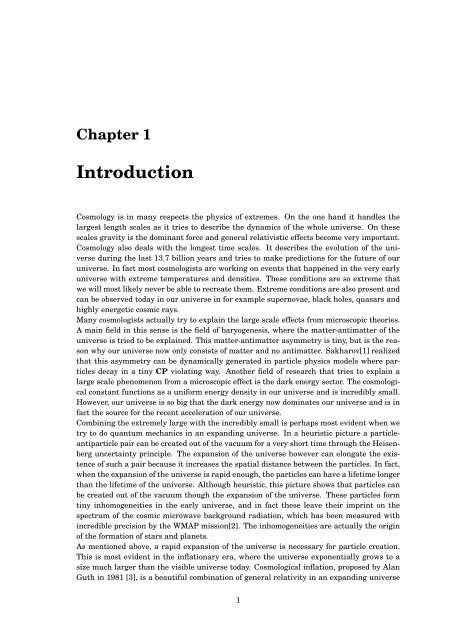Master's Thesis in Theoretical Physics - Universiteit Utrecht
Master's Thesis in Theoretical Physics - Universiteit Utrecht
Master's Thesis in Theoretical Physics - Universiteit Utrecht
You also want an ePaper? Increase the reach of your titles
YUMPU automatically turns print PDFs into web optimized ePapers that Google loves.
Chapter 1IntroductionCosmology is <strong>in</strong> many respects the physics of extremes. On the one hand it handles thelargest length scales as it tries to describe the dynamics of the whole universe. On thesescales gravity is the dom<strong>in</strong>ant force and general relativistic effects become very important.Cosmology also deals with the longest time scales. It describes the evolution of the universedur<strong>in</strong>g the last 13.7 billion years and tries to make predictions for the future of ouruniverse. In fact most cosmologists are work<strong>in</strong>g on events that happened <strong>in</strong> the very earlyuniverse with extreme temperatures and densities. These conditions are so extreme thatwe will most likely never be able to recreate them. Extreme conditions are also present andcan be observed today <strong>in</strong> our universe <strong>in</strong> for example supernovae, black holes, quasars andhighly energetic cosmic rays.Many cosmologists actually try to expla<strong>in</strong> the large scale effects from microscopic theories.A ma<strong>in</strong> field <strong>in</strong> this sense is the field of baryogenesis, where the matter-antimatter of theuniverse is tried to be expla<strong>in</strong>ed. This matter-antimatter asymmetry is t<strong>in</strong>y, but is the reasonwhy our universe now only consists of matter and no antimatter. Sakharov[1] realizedthat this asymmetry can be dynamically generated <strong>in</strong> particle physics models where particlesdecay <strong>in</strong> a t<strong>in</strong>y CP violat<strong>in</strong>g way. Another field of research that tries to expla<strong>in</strong> alarge scale phenomenon from a microscopic effect is the dark energy sector. The cosmologicalconstant functions as a uniform energy density <strong>in</strong> our universe and is <strong>in</strong>credibly small.However, our universe is so big that the dark energy now dom<strong>in</strong>ates our universe and is <strong>in</strong>fact the source for the recent acceleration of our universe.Comb<strong>in</strong><strong>in</strong>g the extremely large with the <strong>in</strong>credibly small is perhaps most evident when wetry to do quantum mechanics <strong>in</strong> an expand<strong>in</strong>g universe. In a heuristic picture a particleantiparticlepair can be created out of the vacuum for a very short time through the Heisenberguncerta<strong>in</strong>ty pr<strong>in</strong>ciple. The expansion of the universe however can elongate the existenceof such a pair because it <strong>in</strong>creases the spatial distance between the particles. In fact,when the expansion of the universe is rapid enough, the particles can have a lifetime longerthan the lifetime of the universe. Although heuristic, this picture shows that particles canbe created out of the vacuum though the expansion of the universe. These particles formt<strong>in</strong>y <strong>in</strong>homogeneities <strong>in</strong> the early universe, and <strong>in</strong> fact these leave their impr<strong>in</strong>t on thespectrum of the cosmic microwave background radiation, which has been measured with<strong>in</strong>credible precision by the WMAP mission[2]. The <strong>in</strong>homogeneities are actually the orig<strong>in</strong>of the formation of stars and planets.As mentioned above, a rapid expansion of the universe is necessary for particle creation.This is most evident <strong>in</strong> the <strong>in</strong>flationary era, where the universe exponentially grows to asize much larger than the visible universe today. Cosmological <strong>in</strong>flation, proposed by AlanGuth <strong>in</strong> 1981 [3], is a beautiful comb<strong>in</strong>ation of general relativity <strong>in</strong> an expand<strong>in</strong>g universe1
















